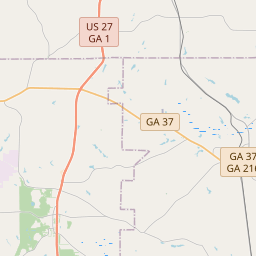Weston C. Lee Veterans Memorial Park
Historical marker location:
Bluffton, Georgia
( Memorial is at the intersection of Pine Street and Fort Gaines Road, on the right when traveling north on Pine Street.)







© OpenStreetMap contributors
The famous Coca-Cola soft drink was invented in Georgia in 1886 by pharmacist John Pemberton.
About Clay County
Clay County Timeline
Clay County, located in southwestern Georgia, has a rich history that dates back to prehistoric times. The area was originally inhabited by Indigenous peoples, such as the Hitchiti and Creek tribes, who relied on the Flint River for sustenance and trade. The first European explorers arrived in the 16th century, with Spanish expedition led by Hernando de Soto passing through the area.
In the early 19th century, Clay County was part of the original lands ceded by the Creek Nation to the United States through the Treaty of Fort Jackson. The region developed as an agricultural area, with cotton becoming the dominant crop, and the economy heavily reliant on slave labor. The county itself was officially established in 1854 and named in honor of Henry Clay, a prominent American statesman.
During the Civil War, Clay County, like many other parts of the South, experienced the devastating effects of the conflict. Many residents fought for the Confederacy, leading to a significant loss of life and economic stability. The end of the war marked the beginning of the Reconstruction era, which brought significant challenges to Clay County, including the dismantling of the plantation system and efforts to integrate formerly enslaved individuals into society.
In the decades that followed, Clay County continued to rely on agriculture, primarily cotton and peanuts, as the backbone of its economy. However, the Great Depression of the 1930s brought hardships to the region, resulting in population decline and economic struggles. In an effort to combat these challenges, the county government implemented various programs and initiatives, including the establishment of community centers and the introduction of electricity to rural areas.
Today, Clay County is a small, rural community that retains its agricultural roots but also promotes tourism and outdoor recreation. Its history is honored through local museums and historic sites, providing visitors and residents alike with a glimpse into the past. Though faced with its share of trials throughout history, Clay County continues to persevere and maintain its unique identity.
In the early 19th century, Clay County was part of the original lands ceded by the Creek Nation to the United States through the Treaty of Fort Jackson. The region developed as an agricultural area, with cotton becoming the dominant crop, and the economy heavily reliant on slave labor. The county itself was officially established in 1854 and named in honor of Henry Clay, a prominent American statesman.
During the Civil War, Clay County, like many other parts of the South, experienced the devastating effects of the conflict. Many residents fought for the Confederacy, leading to a significant loss of life and economic stability. The end of the war marked the beginning of the Reconstruction era, which brought significant challenges to Clay County, including the dismantling of the plantation system and efforts to integrate formerly enslaved individuals into society.
In the decades that followed, Clay County continued to rely on agriculture, primarily cotton and peanuts, as the backbone of its economy. However, the Great Depression of the 1930s brought hardships to the region, resulting in population decline and economic struggles. In an effort to combat these challenges, the county government implemented various programs and initiatives, including the establishment of community centers and the introduction of electricity to rural areas.
Today, Clay County is a small, rural community that retains its agricultural roots but also promotes tourism and outdoor recreation. Its history is honored through local museums and historic sites, providing visitors and residents alike with a glimpse into the past. Though faced with its share of trials throughout history, Clay County continues to persevere and maintain its unique identity.
Clay County Timeline
This timeline provides a concise overview of the key events in the history of Clay County, Georgia.
- 1824 - Clay County was established as the 56th county in Georgia.
- 1832 - Fort Gaines became the county seat.
- 1836 - The Second Seminole War led to the abandonment of Fort Hughes.
- 1861-1865 - Clay County residents actively participated in the Civil War.
- 1870 - The county's population reached its peak with over 10,000 residents.
- 1910 - Clay County's population began to decline due to the boll weevil infestation.
- 1928 - Construction of Lake Walter F. George (now known as Lake Eufaula) began.
- 1930s - The Great Depression brought further economic decline to the county.
- 1941-1945 - Many young men from Clay County served in World War II.
- 1963 - The county's population reached its lowest point with under 2,000 residents.
- 1980 - Clay County experienced a small population growth after years of decline.
- Present - Clay County continues to be a small rural community in Georgia.